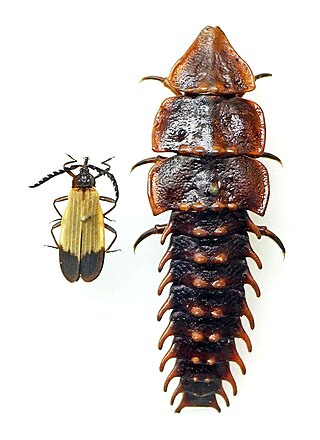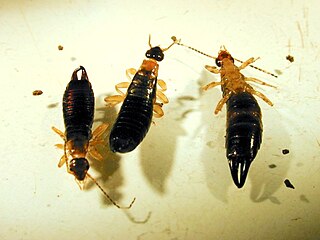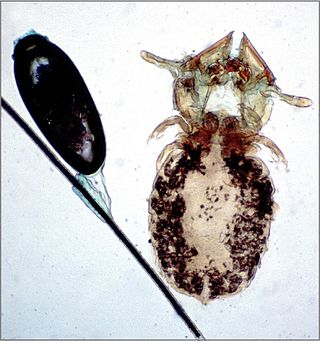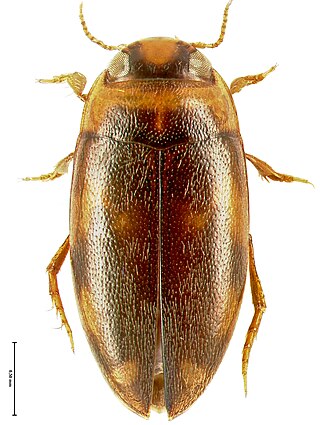
Pygidicranidae is a family of earwigs in the suborder Neodermaptera. The family currently contains twelve subfamilies and twenty six genera. Eight of the subfamilies are monotypic, each containing a single genus. Of the subfamilies, both Astreptolabidinae and Burmapygiinae are extinct and known solely from fossils found in Burmese amber. Similarly Archaeosoma, Gallinympha, and Geosoma, which have not been placed into any of the subfamilies, are also known only from fossils. Living members of the family are found in Australia, South Africa, North America, and Asia. The monotypic genus Anataelia, described by Ignacio Bolivar in 1899, is found only on the Canary Islands. As with all members of Neodermaptera, pygidicranids do not have any ocelli. The typical pygidicranid bodyplan includes a small, flattened-looking body, which has a dense covering of bristly hairs (setae). The pair of cerci at the end of the abdomen are symmetrical in structure. The head is broad, with the fourth, fifth and sixth antenna segments (antennomeres) that are not transverse. In general Pygidicranids also have equally sized ventral cervical sclerites, and in having the rearmost sclerite separated from, or only touching the center of the prosternum. Cannibalism of young has been observed in at least one species in the family, Challia hongkongensis, in which an adult female was found eating a still-living nymph of the same species. The same species in a different area has been observed possibly eating fruits or seeds, making the species an omnivore.

Troctomorpha is one of the three major suborders of Psocodea (barklice, booklice, and parasitic lice), alongside Psocomorpha and Trogiomorpha. There are more than 30 families and 5,800 described species in Troctomorpha. The order includes parasitic lice, which are most closely related to the booklice family Liposcelididae.

Platerodrilus is a genus of beetles of the family Lycidae. They commonly appear in the literature under the name Duliticola, which is an obsolete junior synonym. The females retain a larval form as adults and are about 40–80 mm in length. The females and larvae have a flattened, dark body with large scales over the head, resembling trilobites, hence the informal names trilobite beetle, trilobite larva or Sumatran trilobite larva. In contrast, the males are much smaller, 8–9 mm, resembling other beetles. Species are found in tropical forests of India and South-east Asia.

Euborellia is a genus of earwigs in the subfamily Anisolabidinae. This genus, which has a world-wide distribution, was erected by Malcolm Burr in 1909 and was cited by Srivastava in Part 2 of Fauna of India.

Chelisochidae is a family of earwigs whose members are commonly known as black earwigs. The family contains a total of approximately 96 species, spread across sixteen genera in three subfamilies.

Doru is a genus of earwigs in the family Forficulidae.

Acrida is a genus of grasshoppers in the family Acrididae. The genus contains around 40 species which are found in Africa, Europe, Asia, North America, Hawaii, and Australia. Insects of this genus are omnivorous and a well-known pest of many agricultural crops.
This taxonomy of the Dermaptera follows Engel & Haas (2007) to the rank of genus.
Eucithara vittata is a small sea snail, a marine gastropod mollusk in the family Mangeliidae.

Trichodectidae is a family of louse in the suborder Ischnocera. Its species are parasites of mammals. The following 19 genera are recognized:

Marava is a genus of earwigs in the family Spongiphoridae; most records are from the Americas, but M. arachidis is cosmopolitan. There are more than 50 described species in Marava.

Roger Steinmann is a Swiss entrepreneur and creative in film and theater.
Damalinia is a genus of lice belonging to the family Trichodectidae.
Irdex is a genus of earwigs belonging to the subfamily Spongiphorinae.

Solenopotes is a genus of lice belonging to the family Linognathidae.
Bovicola is a genus of lice belonging to the family Trichodectidae.

Labia is a genus of earwigs belonging to the family Spongiphoridae.

Neobidessodes mjobergi is a carnivorous subterranean water beetle, in the Bidessini tribe of the Dytiscidae family. It was first described in 1922 by Alois Zimmermann as Bidessus mjobergi, and reassigned to the genus of Neobidessodes in 2009 by Hendrich and others.
Liparura is a genus of earwigs within the family Forficulidae.













